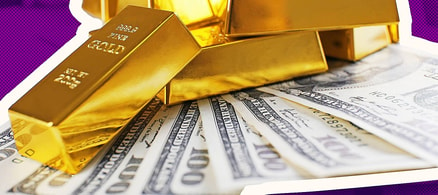What are NFTs?
As with all investments, your first step is to understand what you're investing in. NFT stands for “non-fungible token.” Let's break that down — and why the “non-fungible” part is such a big deal — by explaining tokens.
A token is a digital asset that stores value on a blockchain — a giant unified global digital ledger that can be read and added to but never overwritten, hacked or corrupted. You can have a token that represents 10 bitcoins or 50 shares in a company or any other digital item.
Most tokens on a blockchain are fungible, meaning totally interchangeable. Each token that represents 10 bitcoins is exactly the same — just like how every $100 bill is the same, every share of GOOGL is the same, etc.

A non-fungible token is one of a kind. There is no other token like it on the blockchain, so it's wholly unique.
An NFT allows a user to create a unique string of data on the blockchain. For example, a string that says, in effect, “Chris Butsch owns the original Nyan Cat.”
In short, NFTs are digital certificates of ownership. They can be used for deeds to a car, legal documents, event tickets, collectibles and even real estate.
Learn more:What Are Real Estate NFTs? Everything You Need to Know
But NFTs are an especially big deal for digital artists because it allows them to mint an “original.”
More on that in a bit.
Meet Your Retirement Goals Effortlessly
The road to retirement may seem long, but with WiserAdvisor, you can find a trusted partner to guide you every step of the way
WiserAdvisor matches you with vetted financial advisors that offer personalized advice to help you to make the right choices, invest wisely, and secure the retirement you've always dreamed of. Start planning early, and get your retirement mapped out today.
Get StartedHow do NFTs work and what do they have to do with crypto?
NFTs are powered by the second most popular crypto by market cap, Ethereum (ETH).
Launched in 2015, the Ethereum blockchain allows users to record strings of data — not just stores of value — to the blockchain. And in addition to the ability to generate NFTs, Ethereum is also faster and more eco-friendly than Bitcoin, hence its popularity.
In other words, NFTs live on a blockchain.
The first blockchain, created by the mysterious Satoshi Nakamoto in 2009, could store only bitcoin transactions. But it didn't take long for people to start asking, “What else can we store on a blockchain?”
Such thinking gave rise to the Ethereum blockchain, a next-gen blockchain that uses a technology called smart contracts to allow users to store unique strings of data (non-fungibles).
So, while the Bitcoin blockchain is restricted to storing data that figuratively says this:
User 15631316331 owns 1.163 BTC
The Ethereum blockchain allows for storage of data that figuratively says this:
Kayla H owns Nyan Cat
That, in essence, is what an NFT is. An NFT is a “certificate of ownership” for a piece of art or other digital asset.
For clarity, the actual art is not on the blockchain. Storing data on the blockchain is extremely resource intensive and expensive. So JPGs and GIFs aren't stored there (for now). The Ethereum blockchain just stores the NFT, the record of who currently owns it.
Today, the Ethereum blockchain is still the most popular destination for uploading and storing NFTs. Competitors are coming along. But with the even higher-tech Ethereum 2.0 blockchain coming in 2022, Ethereum will likely remain the best destination for NFT storage.
What are some of the most expensive NFTs?
Would you pay $69 million for the right to say that you “own” the digital version of this collage by digital artist Beeple?
Or if that's a little out of budget, how about a mere $600,000 for Nyan Cat?
These are just two examples of the most expensive NFTs sold so far, proving that the sale price of a digital artwork can very much mirror its tangible, real-world equivalent.
Of course not all NFTs sell for the price of a Rolls-Royce (or a Rolls-Royce factory).
According to artist and data scraper Kimberly Parker, the median sale price of an NFT is under $200 — and that's before fees, which amount to around $85 per listing.
Stop overpaying for home insurance
Home insurance is an essential expense – one that can often be pricey. You can lower your monthly recurring expenses by finding a more economical alternative for home insurance.
SmartFinancial can help you do just that. SmartFinancial’s online marketplace of vetted home insurance providers allows you to quickly shop around for rates from the country’s top insurance companies, and ensure you’re paying the lowest price possible for your home insurance.
Explore better ratesHow to invest in NFTs
Now that we've covered the basics of NFTs, let's go window shopping. How and where do you buy these things?
Unfortunately, you can't buy NFTs on Amazon (not yet, at least).
For now, the world's biggest NFT marketplace is OpenSea.

OpenSea functions more like eBay than Amazon, with most NFTs selling auction style. But just like on eBay, sellers can still list a buy-it-now price.

Prices are listed in ether — not USD. Ether is the transaction token — the “fuel” — powering the Ethereum blockchain.
OpenSea isn't the only NFT marketplace — there's also Binance NFT, Rarible and others. But for now, OpenSea is the biggest and best place to start.
How to purchase your first NFT
Since NFTs are generated and purchased using crypto, the steps involved in buying an NFT are a little more involved than buying a toothbrush on Amazon.
- Register a new account with OpenSea or competing NFT marketplace.
- Create a crypto wallet and purchase some ether. (Keep in mind you'll pay gas fees.)
- Link your crypto wallet to your OpenSea account.
- Start bidding on NFTs.
You can buy Ether on virtually any of the top crypto exchanges like Coinbase or Gemini. But if you're just getting started, how much Ether should you buy?
Well, none to start. You don't need to fill your wallet just to browse for NFTs. You can wait until you find an NFT you like, then purchase some ether to fund your transaction.
Why do people buy NFTs?
Now you may be wondering, “Who's buying these things and why?”
If most NFTs don't include anything tangible or even any copyright, why are people investing all this money in them?
Well, people invest in NFTs for many of the same reasons they invest in tangible art, including, but not limited to:
- To support creatives and digital artists: Some NFT buyers simply want to support the digital artists creating them.
- As an investment: Many NFT buyers see their purchase as an investment, believing the artist's work will appreciate in value faster than the ether they spent on it.
- The joy of collecting: Like many real-world art collectors, a small percentage of NFT buyers may simply like the act of collecting digital art.
I like to think that 3F Music, the Dubai-based music studio that paid $500,000 for the “Disaster Girl” NFT, might've felt a mix of all three motivators.
- It wanted to support Zoë Roth and thank her for bringing so much joy to the internet.
- 3F saw an NFT of a legendary global meme as a good investment. (It probably is.)
- Judging by its Twitter history, 3F just likes buying NFTs.
Next question: Are NFTs a good investment? More on that later. For now, let's talk about how to sell NFTs.
How to create and sell NFTs in 7 steps
Before we talk fees and why NFT sales aren't as glorious and profitable as the headlines suggest, here's a summary of the steps involved in listing your first NFT on OpenSea:
- Create a crypto wallet.
- Link your wallet to your OpenSea account.
- Buy some ETH. (Keep in mind you'll need to pay some fees.)
- Create a “collection” of your art.
- Generate an NFT from your collection.
- List your NFT for sale.
- Market your NFT to your fans.
When someone buys your NFT, you'll be paid in ETH — so an eighth step may be to convert your ETH back into USD.
So what are the fees associated with NFT sales?
How much does it cost to generate a single NFT?
The cost to mint (aka generate) and list an NFT for sale is around $85, according to NFT's Street. And you'll also owe the exchange a portion of your selling price.
Prices can vary wildly depending on your chosen platform, the value of ETH that day, etc. But that's the rough number to plan for.
$85 is a lot. But when compared to the cost of art supplies, gallery space, booth rentals, etc., it's actually not too bad.
But is it worth it?
How much can you make selling NFT art?
It totally depends on whether your audience is hungry for your NFTs. If you're just starting out, you may want to temper your expectations.
Just the title of Kimberly Parker's compilation of NFT data (“Most artists are not making money off NFTs and here are some graphs to prove it”) paints a pretty clear picture.
Parker published the following findings. (“Primary Sales” refers to an artist's first NFT sale on OpenSea.)
- 33.6% of Primary Sales were $100 or less
- 20.0% of Primary Sales were $100–$200
- 11.1% of Primary Sales were $200–$300
- 7.7% of Primary Sales were $300–$400
- 3.9% of Primary Sales were $400–500
- 3.3% of Primary Sales were $500–$600
- 2.5% of Primary Sales were $600–$700
In short, most NFTs sell for under $200 — if at all — and many barely cover the listing fees. Plus according to Parker's research, 67.6% of sellers have not had a secondary sale.
Many artists struggle to sell their NFTs simply because there's such a limited buyer pool. In order to purchase an NFT, a buyer must:
- appreciate art,
- understand NFTs, and
- purchase cryptocurrency.
At present, barriers two and three prevent a wider audience from dabbling in NFTs.
That said, hopefully over time NFTs will go mainstream enough to remove some of these barriers — namely, allowing people with no crypto knowledge to buy them with cash.
Pros and cons of NFTs
Pros
- Empower digital artists: The ability to etch a “certificate of ownership” onto the blockchain has allowed creators of virtual art to create and sell “originals.”
- Showcase the power of blockchain technology: NFTs have undoubtedly helped millions more individuals and businesses understand the potential of blockchain technology beyond a ledger for cryptocurrency transactions.
Cons
- High listing fees: Listing fees as high as $120 per NFT are a barrier for lesser-known artists.
- Limited buyer pool: Purchasing NFTs requires a crypto wallet with ETH plus an understanding of what NFTs are — severely limiting the buyer pool.
- Environmental impact: Ethereum is planning a shift to an eco-friendly proof of stake (PoS) model in 2022. But until then, some artists protest the rise of NFTs due to their massive environmental impact.
Is an NFT investment right for you?
All things considered, is an NFT a smart investment?
1. If you'd like to support the artist, yes.
The most sound and logical reason to buy an NFT these days is to support an artist that you believe in.
NFTs are a big risk for artists — they cost time and money to mint, and many artists may not be aware of the limited buyer pool until it's too late.
Therefore, you can seriously make an artist's day by purchasing their NFT and flouting it on social media, helping them drive more traffic.
2. If you'd like to profit, probably not.
If investing in cryptocurrency itself is 100% speculation, investing in NFTs is even more so.
Simply put, NFTs are “not primarily an investment” and are “even crazier than investing in crypto.” That's coming from Vignesh Sundaresan (aka MetaKovan), the guy who paid $69 million for the Beeple NFT. He told Bloomberg that anyone trying to profit from NFTs is “taking a big risk.”
Beeple told CoinDesk in March 2021, “I do think there is a bubble,” and sure enough, NFT sales plummeted in April. Melissa Gilmour, founder of NFT agency Lily & Piper, commented, “A drop in value was inevitable.” As the initial craze faded, NFTs faced growing pains with oversaturation, compatibility issues and a rise in scams.
But by late summer, investors were again bullish on NFTs. Trading volume hit $10.7 billion in Q3, according to CNBC, largely driven by support from A-Listers like Shaq and Snoop Dogg.
But even if a Snoop Dogg NFT seems like a good investment, which one should you buy? Will there be a buyer for your specific NFT in three months? Three years?
Therein lies the challenge of investing in non-fungibles. There's no guaranteed buyer on the other end of your investment like there is with shares of stock, less so one that will pay a higher price than you paid.
Will some NFTs skyrocket to the value of a house? Probably.
Does that make them a good investment? No.
If you're looking to grow your money in a way that involves significantly less time, effort and risk, check out our guide, “How to Invest $50k.”
Bottom line
NFTs are both fascinating and empowering. And they allow digital artists to sell their art in a totally new way.
However, contrary to what a few high-ticket sales imply, they're not a hidden cash cow for creative types. High fees, technical barriers and a limited buyer pool make NFT generation a risky prospect — for now.
NFT values are also too unstable to be considered a safe investment. Luckily, many safer, more reliable alternatives exist.
Related posts:
- Are NFTs securities?
- 3 reasons you should buy an NFT (And 1 Big Reason You Shouldn’t)
- How to spot an NFT scam
Sponsored
Follow These Steps if you Want to Retire Early
Secure your financial future with a tailored plan to maximize investments, navigate taxes, and retire comfortably.
Zoe Financial is an online platform that can match you with a network of vetted fiduciary advisors who are evaluated based on their credentials, education, experience, and pricing. The best part? - there is no fee to find an advisor.










